|
|
|
Sort Order |
|
|
|
Items / Page
|
|
|
|
|
|
|
| Srl | Item |
| 1 |
ID:
100220
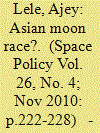

|
|
|
|
|
| Publication |
2010.
|
| Summary/Abstract |
After a gap of 40 years, the Moon is again the focus of several countries' space ambitions. Japan, China and India have already launched their first Moon missions and are expected to send humans moonwards within the next 10-15 years. This revival of lunar programmes in the post-cold war era goes beyond symbolism and is also about the race to grab the natural resources of the Moon. Such ambitious missions by these states imply that they intend to change the unipolar world into one with multiple power centres, and would use space technology as one of the components to do so. This paper examines the first phase Moon missions of the Asian states and argues that their overall deep space mission aspirations have strategic ambitions attached.
|
|
|
|
|
|
|
|
|
|
|
|
|
|
|
|
| 2 |
ID:
100219
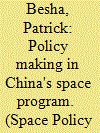

|
|
|
|
|
| Publication |
2010.
|
| Summary/Abstract |
China's space program is one of the most advanced, rapidly improving and opaque in the world. Insight into the program's policy-making process could help eliminate misunderstandings, make intentions more clear and promote stability in US-China relations. This case study of China's first lunar orbiting probe traces the project from initial policy proposal through agenda-setting, policy approval and final policy implementation. It reveals a highly rational decision-making process that is ruled by incrementalism, consensus building, scientific judgment and the use of leading small groups to coordinate among ministries. This research was guided by several relevant theories, including the "fragmented authoritarian" framework of power, the theory of the "policy entrepreneur" and the recently developed "inside access model". The paper is one of the first published accounts in the English language to detail, from policy proposal to policy implementation, China's first mission to the Moon.
|
|
|
|
|
|
|
|
|
|
|
|
|
|
|
|
| 3 |
ID:
100221
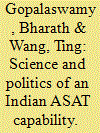

|
|
|
|
|
| Publication |
2010.
|
| Summary/Abstract |
India has recently stated an intention to develop an anti-satellite (ASAT) capability. The reasons for this may include the country's growing economic and political clout, alongside the increasing importance of space to this status, the significance of space assets to the military, a perceived threat from China, and fear of being disadvantaged in future treaty negotiations if not 'in the club'. Nevertheless, development and use of an ASAT would have potentially catastrophic debris-related consequences that would also create major political problems for the user. The state of India's ASAT activities is described and recommendations on avoiding hasty development, such as researching methods of protecting satellites, strengthening bilateral relations with China and pushing for a legally binding norm on ASATs, are made.
|
|
|
|
|
|
|
|
|
|
|
|
|
|
|
|
| 4 |
ID:
100223
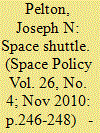

|
|
|
|
|
| Publication |
2010.
|
| Summary/Abstract |
The Space Transportation System (STS), for better or worse, has dominated the US space program for some 30 years and is now an American icon. The Space Shuttle orbiters have flown over 120 missions and certainly accomplished some amazing feats, including the deployment of the International Space Station (ISS), the launch and double repair of the Hubble Telescope, a number of classified missions for the US defense establishment and the cementing of international cooperation in space. As the remaining Space Shuttle orbiters head toward various museums, it is timely to look at the STS program in terms of key US space policy decisions that have paralleled the Space Shuttle's often troubled history. This article seeks, from both a historical and a policy perspective, to assess what might have been. While noting the major accomplishments of the STS, it also identifies what can best be characterized as major lost opportunities and flawed policy decisions that have had multi-billion dollar consequences. In this regard, the US Congress, the White House, and NASA leadership have all played a role. If there have been failings, they have not been by NASA alone, but the entire US space policy leadership.
|
|
|
|
|
|
|
|
|
|
|
|
|
|
|
|
| 5 |
ID:
100222
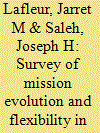

|
|
|
|
|
| Publication |
2010.
|
| Summary/Abstract |
Given the diversity of missions it has accomplished and the myriad of adaptations it has undergone, the US Space Shuttle is widely regarded as a highly flexible space vehicle. With the Shuttle's upcoming 2011 retirement, it is instructive to survey the history of this vehicle's flexibility for the insights it can provide to the design and characterization of flexibility in future space systems. Data are presented on the evolution of mission requirements over time for 120 missions performed by the Space Shuttle over a period of some 27 years. Distinct trends in the time domain - as well as their causes - are identified and discussed, and early manifest plans from 1982 serve as a confirmation that these trends were not originally anticipated. Eight examples are then presented of engineering modifications that allowed the Shuttle to adapt and accommodate these requirement changes. Several additional instances of Shuttle flexibility are explored, such as post-Columbia disaster modification, upgrade programs and derived vehicles, and one case in which flexibility was inhibited by an early design decision.
|
|
|
|
|
|
|
|
|
|
|
|
|
|
|
|
|
|
|
|
|